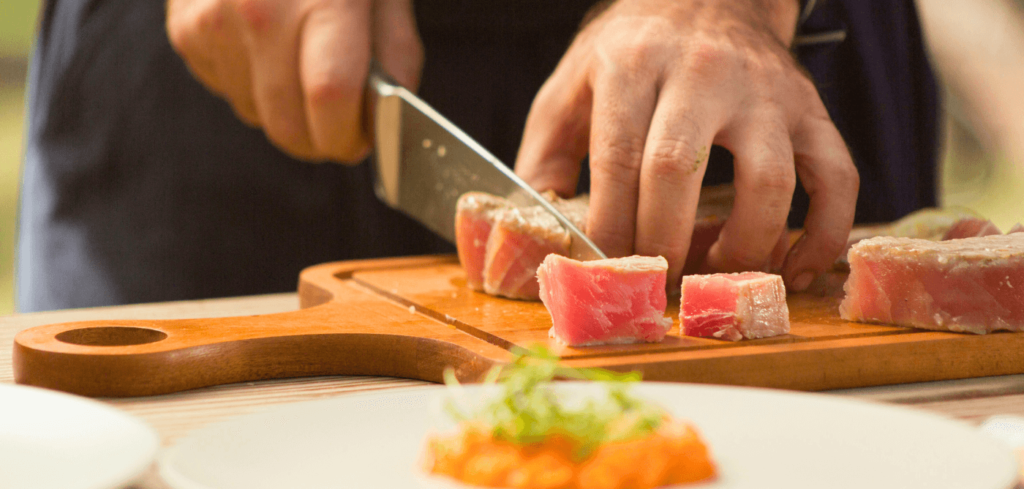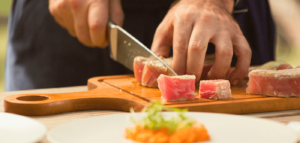
A sharp knife is a safe knife. With a freshly sharpened blade, you can slice, chop, and dice with precision. Dull kitchen knives can be dangerous, requiring extra force that can lead to slipping and injuries. Beyond safety, proper knife sharpening also ensures your blades last longer and perform optimally every time you use them.
In this complete guide, you’ll learn how to sharpen kitchen knives at home using a whetstone – the most effective manual sharpening method for superior long-lasting edges.
Why Sharpen Your Knives?
Before we get into the sharpening techniques, let’s look at the key reasons you should be sharpening your kitchen knives regularly:
Enhanced Cutting Performance
Sharper knives glide through foods effortlessly. The razor-thin edge of a sharp knife slices cleanly through ingredients – no squashing, bruising, or tearing. You’ll notice a clear difference in how soft foods like tomatoes and meat are cut with a finely honed knife.
Easier and Safer Cutting
A sharper blade requires significantly less force to cut through foods. With a dull knife, you need to apply more pressure to complete slices and chops, which can cause the blade to slip unexpectedly. Sharpening removes the dull rounded edge that leads to accidents.
Extended Knife Lifespan
Like any cutting tool, knives naturally degrade with use over time. The small micro-abrasions that dull the cutting edge can, if left unchecked, start wearing away more metal along the blade. Proper sharpening restores the edge so the knife steel maintains integrity longer.
More Economical Than Replacing Knives
Quality kitchen knives can have hefty price tags. Sharpening costs just a small fraction in comparison to replacing knives. Even affordable but good knives last much longer when sharpened regularly. Sharpening is an essential maintenance skill for frugality.
Sold on keeping your knives sharply honed? Let’s look at the best way for at-home sharpening using a whetstone.
Selecting the Right Whetstone
Whetstones, also called sharpening stones, are rectangular blocks made of natural or synthetic abrasive materials. As you slide the knife’s edge across the stone, it sands off tiny bits of metal to reveal a fresh and straight edge.
Whetstones come in varying grit sizes, which determine how coarse or fine the sharpening results will be. Coarser stones remove metal more quickly but leave a rougher edge, while finer grits produce razor-sharp polished edges that take more time.
For sharpening kitchen knives, a good beginner whetstone is 1000/6000 grit. The 1000 grit side repairs damaged edges quickly, while the 6000 leaves an exquisitely sharp and smooth finish.
Other whetstone options include:
- 400/1000 grit – Best for repairing very dull damaged blades. The coarse 400 grit restores the edge quickly.
- 3000/8000 grit – Ideal for finishing and polishing an already sharp edge to hair-splitting sharpness.
- Natural whetstones – Made from materials like novaculite or Belgian coticule that use very fine natural abrasives. Require more skill but produce superior edges.
Synthetic whetstones are the most common for beginners. They cut metal consistently and are more affordable than natural stones. Brands like Sharp Pebble and BearMoo offer combination grit whetstones at reasonable prices.
Preparing the Whetstone for Sharpening
Before using your new whetstone, it needs some initial preparation depending on the type:
- For oilstones (natural whetstones), apply honing oil over the surface. This lubricates the stone to prevent the knife from getting stuck.
- With synthetic whetstones, soak in water for 5-10 minutes until bubbly. This allows the pores to absorb water and prevents metal shavings from clogging the stone.
- Diamond whetstones can be used dry or with a bit of water. No soaking needed, just spritz on a little water.
- Always keep a tray or dish under the whetstone to catch the water drippings, metal bits, and grinding swarf.
Holding the Knife at the Right Angle
Maintaining a consistent angle as you sharpen is crucial for proper edge beveling. Most kitchen knives should sharpen at a 15-20 degree angle per side.
To find the right angle:
- Rest the heel of knife on the stone with spine tilted up.
- Raise the handle until you feel the knife ‘bite’ into the whetstone.
- Keep the angle steady as you slide the blade along the stone.
Use your opposite hand placed on top of the blade to apply even pressure downwards. Aim to keep the angle fixed throughout the entire stroke. Consistency creates a nicely beveled edge.
Some tips for maintaining angle:
- Adjust your body position over the stone to feel comfortable securing the angle.
- Go slowly and check angle frequently. Markers on the blade can help visualize the angle.
- Practice first without cutting to get the right angle in your muscle memory.
Steps for Sharpening the Knife
Now for the sharpening steps. We’ll cover sharpening along the whetstone’s 1000 grit side first:
- Start with the heel of the knife at the near top edge of stone, blade facing away.
- Maintain your angle and use gentle pressure to pull the blade down and off the edge of stone in one smooth motion. Move from wrist, not arm.
- Flip knife over and repeat a pull stoke this time along the other side of blade. Alternate sides with each full pass.
- Check for burr formation by running your fingertip from spine to edge. A slight burr on one side means it’s time to switch sides.
- Continue passes on each side, counting strokes. Switching at every 8-15 strokes balances wear.
- Work down length of blade in sections. Move knife lower on the stone and repeat pulls at the same angle.
- Slice into the stone edge to deburr after each section. Turn blade over and repeat to remove burr completely.
- Repeat process until knife edge is restored. Softer steel requires more strokes. Aim for about 100-150 total pulls per side for an average kitchen knife.
Once the knife edge is restored and feels sharp, flip the whetstone over to the 6000 grit side. Use lighter pressure for 5-10 pulls per side to refine and polish the edge. This yields a super sharp and smooth edge perfect for kitchen use.
Finishing with Honing for Straight Edge
While whetstone sharpening realigns the cutting edge, honing helps keep the edge straight between sharpening. Use a honing steel, ceramic rod, or strop regularly before using knives.
To hone with a steel:
- Hold steel vertically on cutting board or counter.
- Place knife edge against steel at about 15-20 degree angle.
- Apply light downward pressure as you slide knife from bottom to tip.
- Alternate sides for 6-8 strokes on each.
Frequent honing aligns any minor folds in the edge to keep knives slicing straight.
Maintaining the Sharp Edge
Sharpening with whetstones should be done whenever knives noticeably dull. As a general rule, plan to sharpen kitchen knives:
- Every 3-6 months with frequent use
- Every 6-12 months with moderate use
- Annually or less with light use
Hone blades briefly before each use for straight edges between sharpening. Avoid cutting into hard surfaces like glass or metal which rapidly dull edges. Store knives securely in a block, sheath or drawer to prevent nicks.
With the proper care, your kitchen knives can keep impressive edges for many years of service. Learning to wield a whetstone well is a valuable skill that will save you money and keep your knives performing optimally.
Conclusion
The simple act of sharpening a kitchen knife with a whetstone is transformative. As you draw the blade across the stone, you can actually feel the dull edge give way to a razor sharpness. And the results are evident in use – knives glide through produce effortlessly and cleanly.
In this guide, we covered the essentials of manual knife sharpening using a whetstone – from choosing the right stone to proper sharpening technique. With a quality whetstone and some practice maintaining the angle, anyone can learn to produce professional-level edges. Remember to finish honing with a steel for straight slices.
Though it takes patience and skill, there is something immensely satisfying about sharpening knives yourself. Your knives will perform better than ever, saving you money and needless replacement. More importantly, you can take pride knowing your knives are tuned for both top performance and safety.



